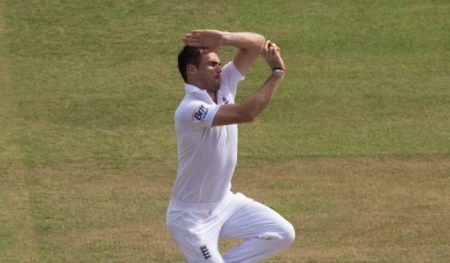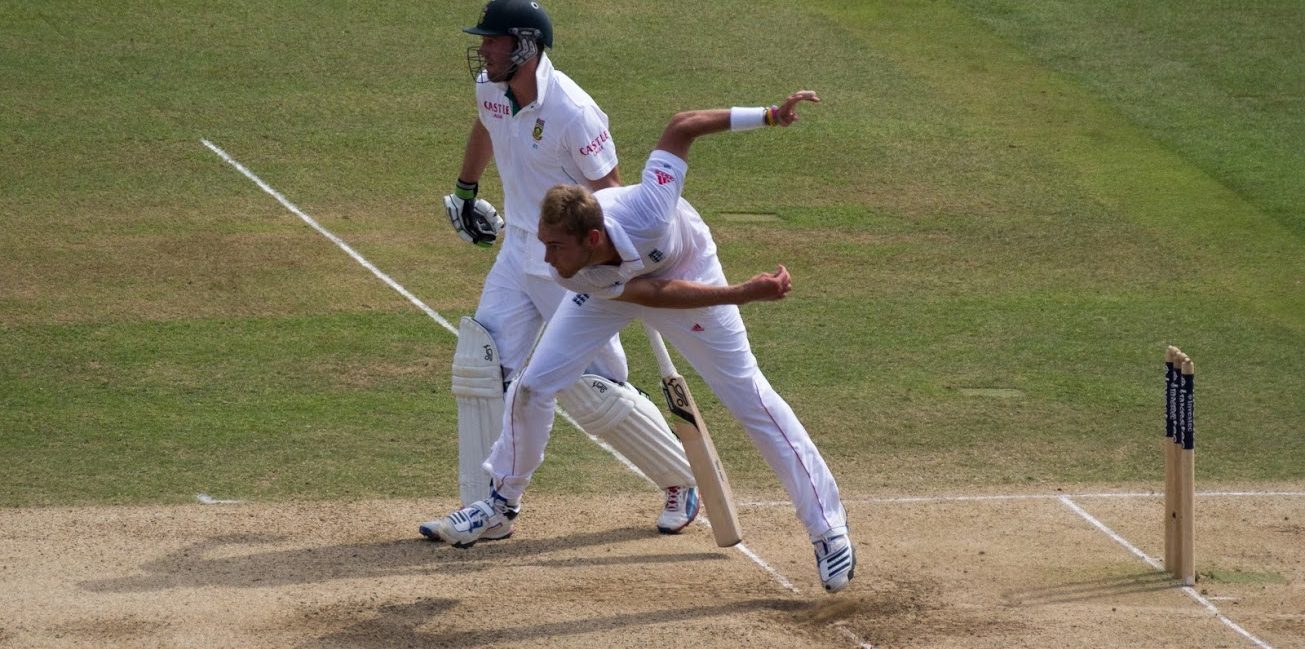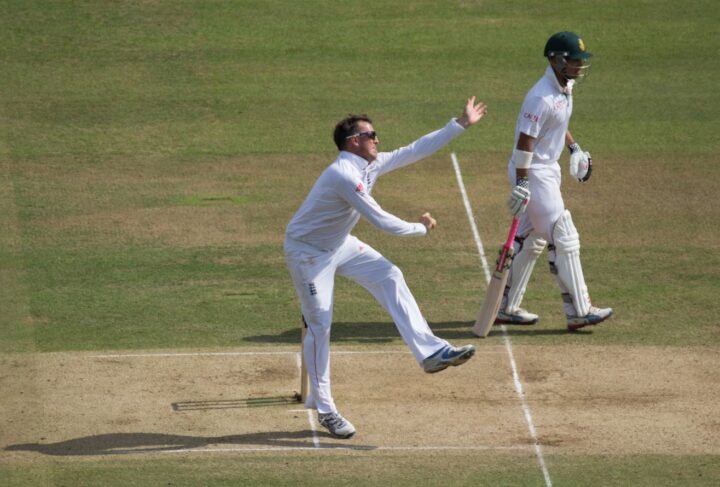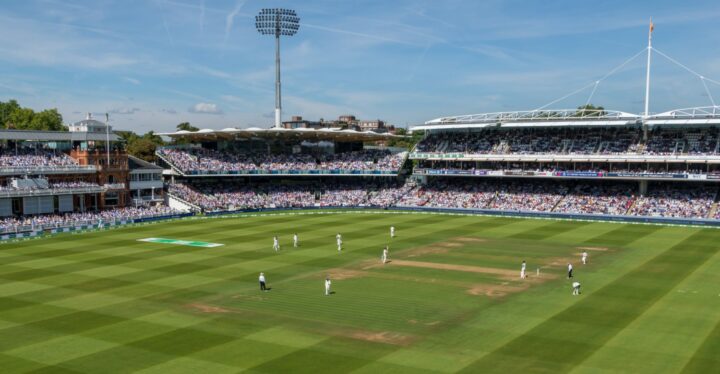Ladies and gentlemen. Welcome to today’s bowling beauty pageant. We have two awesome couples on which to feast your eyes – one couple who are still strutting their stuff amongst the movers and shakers of world cricket, and another couple (a somewhat odd couple) who played a big part in England’s revival in the early 2000s.
So without further ado, let’s run the rule over the contestants …
On the left catwalk, wearing expensive suits, we have Anderson and Broad. They go together like Crockett and Tubbs or Holmes and Watson. Statistically they’re England’s most prolific bowling combo of all time with a joint total of 1,069 Test wickets. They’re the bookies favourites.
On the right catwalk, wearing the pink leotards, we have Darren Gough and Andy Caddick, who go together like, erm, Arnold Schwarzenegger and Danny Devito or maybe Kermit and Miss Piggy (I’ll leave you to decide which is which). They took 463 Test wickets between them – not a bad haul at all, but today they’re outsiders.
So which combination was best? The answer may seem obvious at first but appearances – or perhaps I should say popular perceptions – can sometimes be deceptive. Despite the disparity in total wickets – 1,069 plays 463 – we should also look at how many games they played …
Jimmy and Stuart have played a whopping 289 Tests thus far, whereas Dazzler and Caddie played just 120. This means – excuse me while I grab my calculator – that today’s underdogs actually took more wickets per Test: 3.86 versus 3.7. And the ECB weren’t even preparing green tops to mask England’s deficiencies twenty years ago (wink, wink).
Now let’s look at their career averages. This is where Jim and Stu come into their own. Jimmy has the best average of all today’s contestants at 26.8. That’s very handy indeed. And old Stu’s no slouch either. He’s taken his Test wickets at 28.5.
As for our other pair, Darren’s taken his wickets at 28.4 (a smidge better than Broady) but Caddie is bringing up the rear with a Test average of 29.9 – not bad I’m sure you’ll agree, but in this elevated company it’s slightly off the pace.
However – and this is quite a big ‘however’ – things aren’t so clear cut when we dig down into the detail. After all, our favourites’ statistical advantage in this category seems to be related to English pitches and Dukes balls.
Test Averages At Home
Anderson – 23.8
Broad – 26.7
Gough – 29.7
Caddick – 30
Unsurprisingly Anderson is king of the castle by a country mile in this table. It’s not even close. But before we anoint Jimmy and his buddy as today’s beauty queens, let’s consider their Test averages away from England’s green and pleasant (at least for bowlers) lands.
Test Averages Away From Home
Gough – 26.9
Caddick – 29.7
Broad – 31.6
Anderson – 33.4
You’ll see it’s quite the role reversal. The king has become the pauper and Goughie, closely followed by his lanky companion, enjoy significant supremacy.
What’s remarkable about these figures is not only how Anderson and Broad turn from world beaters into unremarkable Test bowlers (statistically) once they leave our shores, but also how Gough and Caddick’s performances slightly improve when they leave the lush pastures of Blighty.
In Gough’s case, there’s actually quite a significant improvement away. Jimmy, on the other hand, goes from a transcendent 23.8 at home (which puts him amongst the greats) to a slightly sheepish 33.4 away – almost ten whole runs worse.

So who would you rather take home from today’s pageant and snog / marry / avoid? The answer has probably crystallised in your mind already. If it’s a home Test in England then you’re taking Broaderson every time. But if it’s away from home, say in Sri Lanka or somewhere else dry and hot, you’re edging towards Gougick.
At this juncture, before the swimwear section gets underway, I intend to provide a full breakdown of who averaged what in which countries. However, I must confess this picture is a tad incomplete. Why? Because, believe it or not, Caddick never played a single Test in India and Gough never played a single Test in either India or the West Indies. Weird eh?
Despite this, however, we can still make some interesting comparisons …
Test Averages In Australia
Gough – 27
Caddick – 35
Anderson – 35
Broad – 37
Test Averages in New Zealand
Gough – 19
Caddick – 20
Broad – 28
Anderson – 33
Test Averages in Sri Lanka
Gough – 20
Caddick – 25
Anderson – 46
Broad – 83
Tests in South Africa
Broad – 24
Caddick – 29
Anderson – 35
Gough – 46
Tests In West Indies
Anderson – 25
Caddick – 30
Broad – 31
Gough – NA
Tests In India
Anderson – 33
Broad – 54
Gough – NA
Caddick – NA
* I should quickly mention that I omitted the statistics against Pakistan because they’re not a fair comparison. Caddough actually played in Pakistan itself whereas Anderoad’s games took place in the UAE. Therefore I’m not sure what looking at these stats would prove.
A couple of things strike me about the above ‘figures’ … and I mean their averages not their ‘vital statistics’. Firstly, Gough was pretty much an absolute beauty away from home in all countries apart from South Africa. I expect his skiddy trajectory didn’t really help much in the land of Biltong. Caddick was also remarkably consistent away from home, although he didn’t bowl well in Pakistan (the stat I omitted).
Anderson and Broad, on the other hand, have quite shaky records away from home. Jimmy averages comfortably above the 30 benchmark everywhere other than the West Indies (although he does have a very good record in the UAE).
Meanwhile, Stu Pot very much blows hot and cold. He’s excellent in South Africa, very handy in New Zealand, but garbage in India, utter garbage in Sri Lanka, and not exactly stellar in Australia either.

I found the statistics in Australia particularly interesting because Gough and Caddick (well, Gough mostly) had a very good record down under despite having to bowl at one of the greatest teams in Test history. Gough averaged 27 against the likes of Taylor, Slater, Ponting, Steve Waugh and Mark Waugh on their home turf.
Although the Aussies are never pushovers on their own soil, their batting wasn’t nearly as strong in 2010/11 and even 2013/14 – although they still won comfortably on the latter occasion despite relying on the likes of Shane Watson, Chris Rogers, and George Bailey.
So who are today’s winners? If you like longevity and don’t much care for splitting hairs in a beauty contents – especially as Caddick’s hair went prematurely grey – then you’re probably handing that golden lipstick trophy to Anderson and Broad. And why not? It’s pretty hard to argue with over a thousand Test wickets.
However if, like me, you’re a bit of a contrarian at heart – that’s code for awkward bugger by the way – then you might well be tempted by a bit of Gough and Caddick. After all, even if you’re playing in England you might turn up and find an uncharacteristically dry and flat pitch (especially considering the new drainage systems at places like Lord’s).
The other issue is pace. Jimmy and Broady have all the skills but they don’t really have speed in their locker. A Gough and Caddick partnership actually covers all bases – swing and pace from the Yorkie, and steep bounce and a heavy ball from the Somerset man.
In an ideal world I’d like to pick two from the four and mix things up. There’s absolutely no question, in my humble opinion, that Anderson and Gough are the two best seam bowlers England have produced in the last three decades. I liked me a bit of Flintoff in 2005, of course, but overall I’d take Jimmy and Darren in a heartbeat to lead my fantasy modern England attack.
There’s just one problem though. Neither Jimmy nor Darren are particularly tall. We’d need a taller seamer who hits the pitch hard to back them up. In this instance would you pick Broad or Caddick as your third seamer?
This is a very tricky call indeed. Both were / are superb bowlers on their day. However, because Caddick was more consistent around the world I might just opt for the adopted Kiwi. He can babysit my team’s other ancestral Kiwi, Ben Stokes.
James Morgan









Would the selection change if you could pick someone at the peak of his career? Flintoff 2004-5 was magnificent but his overall career was not. At their peak Gough and Caddick were really something (2000 home to WI and winter tour on subcontinent) albeit it took about a single over for the 2001 Australians to cut them down to size (9 off the first ball of the series).
And there’s the problem which backs up your earlier post about lack of great English players. Last 30 years England would have to face Warne, McGrath, Cummins and peak Mitchell Johnson, and the result wouldn’t be pretty. Nor would bowling to Hayden, Ponting, Smith, SR Waugh and Gilchrist. (Or Kholi, Sewag, SRT, Dravid and Laxman …)
Criteria? Open for debate. I really don’t mind :-) Peak versus non-peak, longevity, ability to win games, it’s all up for grabs in this one.
When I started researching this I thought the case for Anderson and Broad would be undeniable. But the more digging I did the more I thought “hang on, this could be a really interesting one”. In the end I was leaning towards Gough / Caddick because I have a lingering respect for English bowlers who can master overseas conditions. But if the game’s at home there’s no way one can leave out Anderson.
Goughy was effective away from home in most countries because in his pomp, he bowled reverse swing at more than respectable pace. Indeed he probably had the greatest air speed of the four. Anderson was/is the most complete although that wasn’t always the case. He spent the first few years of his career being mightily inconsistent and it was only from around 2010 that he became the bowler we would identify now.
Just doing a quick cricinfo query, his stats from 2010 are a brilliant 21.19 at home and 29.76 away. Two neutral tours of UAE and 6 tests at 20.54. I did find Anderson such an exasperating bowler for years. Just a shame he didn’t get better a couple of years sooner.
Caddick and Gough were possibly the more exciting as both could conjure brilliant spells that blasted out some of the greatest players, Broad had some of that power but he didn’t quite play v the greatest Australian and Indian batsmen in their pomp. Interesting discussion though.
If in-game substitutions were allowed then the ideal solution would be Broad to be third seamer behind Gough and Anderson in the first innings, and then Caddick to take over from him in the second innings (check out the difference between Caddick’s first innings and second innings stats and you will see why this would work so well). With this solution unfortunately not currently permitted the other answer based on the figures you quoted is that Broad gets the nod if it is a home game and Caddick if it is overseas.
Gough’s strike rate was pretty tasty as well if I remember!
Would be interested to see Caddick’s figures against Australia minus dead rubbers. He was the master of the 6 for at the Oval or Sydney when the Ashes were long gone.
Slightly off topic, but would you have Broad or Harmison on their best days?
Definitely Harmison for me. The sight of a bowler – and an English one at that – beating the best batsmen in the world by sheer pace must be one of the finest that Test cricket can offer. Had injuries not intervened and he and either Jones or Flintoff had stayed fit………….!!!
Oh, Jimmy Jimmy… Nothing you say will divert me from my admiration, nay, hero worship of the cricket Matrix’s very own Mister Anderson. His longevity as a pace bowler is little short of miraculous, given the medical horrors that lie in wait for those called on to serve their countries. The fact that he has, like a fine wine, got better with age seems unique among his brethren and it’s obvious his hunger has not deserted him – he was NOT A HAPPY BUNNY when unselected for Sri Lanka. Of course I admire Gough, Caddick and Broad enormously and anyone running the numbers is perfectly entitled to draw their own conclusions but the sheer amount of unadulterated pleasure that Jimmy Anderson has given me over the years as I watched him turn into the undisputed King Of Swing completely outweighs anything any of you might have to say on the subject, so I win!
Interesting piece, and shows that it’s not a simple comparison of wickets taken. Gough’s persistent injury problems slowed his pace and ultimately forced his premature retirement from Test cricket, otherwise he would surely have taken 400+ Test wickets.
I am in the sceptic’s camp on Caddick though. With the possible exception of his 4 in an over against a declining Windies, I am struggling to think of a Test he turned in our favour – too often he came to the party late in a Test we were already on the way to winning anyway.
So it has to be Anderson and Broad for me. Broad has produced a host of match winning spells out of nowhere, and Jimmy’s consistency over the last decade superb – imagine how much better his Test average could have been had he not had his early years wasted by ECB coaches messing with his action.
Gough was the best English bowler I have ever seen in Australia, but you are correct Steve smith aside he bowled against significantly more talented batsmen also. (Although no need to sledge Chris Rogers way worse people have played for Aus than him.)
Outside superb use of the Dukes ball Anderson’s great virtue is the ability to stay fit and bowl long spells. He’s not really an impact bowler overseas.
The problem again is how much faith do you put in statistics if you are going to consider each player at their peak. At their best Anderson and Broad seem to inspire each other. The weak link for me is Caddick who quite frankly could be bloody awful, however consistent Goughie was. I don’t really see them as a pair in the same way. Caddick blew hot and cold throughout his careeer, similar to the much vaunted Harmison.
Personally I would say, purely in terms of class, Willis and Hendrick complemented each other as well as any pair I’ve seen for England up till Broad and Anderson. Both were consistent and made the ball move and rise off a good length. Hendrick would have taken a bundle of wickets in the modern game due to his nagging line and length, as batsmen’s patience would have worn thin quickly, but his just short of a length standard delivery meant he often beat the bat without finding the edge but today’s batsmen would have gone looking for him, so his length would not have been such an issue wicket wise.
I think the statistics away from home are decisive enough to make this a tough call. Caddick was nowhere near as inconsistent as I remembered when I looked at his record. It’s actually very similar around the world wherever England travelled. Although I think Anderson is the trump card here, Gough and Caddick were an excellent partnership that complemented each other well.
People talk about Jimmy and Stuart being England’s best combination ever but that’s mostly based on longevity and the fact England play more games now. As the article mention, Gough / Caddick took more wickets per Test. Broad, for example, is a good bowler but he’s clearly not England’s second best bowler ever. He’s probably not top 10 imho.
It’s like the football argument. Was Wayne Rooney better than Geoff Hurst and Jimmy Greaves? Clearly not imho. But he scored more goals for England.
Longevity is highly relevant. I remember early on in their careers watching Broad and Anderson bowl very ineffectually against the WIndies at Lord’s. We speculated on how many the WIndies of days gone by would have got against them and reckoned that they would have declared sometime on Saturday when they reached 1000 with Richerds on 400+ – assuming they had managed to get rid of Greenidge and Haynes !
The fact that players play more games now can work against consistency, as the pressure to reproduce is greater and the difficulty of maintaining form over longer periods with little respite certainly plays a part in fitness issues. It’s no wonder today bowlers have uninspiring spells. Anderson when he’s on it is the best swing bowler I’ve ever seen and Broad, though inconsistent, can produce match winning spells out of nothing more often than Caddick. We all liked Goughie because he was such a trier, but I don’t think he ever had the presence of Anderson. As I mentioned with Willis and Hendrick as a pair, Hendrick clearly did have that presence, troubling the best regularly.
The footie argument doesn’t really work as the players you mentioned were different types of striker, requiring different contributions from their team mates to be effective. whereas in cricket bowlers are much more their own men and the bowlers we’re talking about were similar types.
Remarkably Caddick has a better record “in Australia” than against Australia. He was apparently much worse against Australia at home although his figures were positively effected by his last test in Australia taking match figures of 10/215. and reducing his bowling average in Australia from 40 to 35.
Caddick has also got the highest bowling average (by a good margin) of anyone who took 60+ wickets in Ashes tests. In Australia he was regarded as a running joke that no-one could understand why he kept getting picked.
I wonder what Ian Watmore thinks? Probably that Gough and Caddick must be a firm of estate agents….
Watmore is an interesting choice. Is he being put in place so that Graves can still effectively control the ECB from the ICC?
No need for me to comment on this particular conundrum, save to say that these type of articles are enjoyably thought provoking. They remind me just how multi dimensional cricket is when trying to make personal judgements.
Thanks, James!
No worries Andy. Thanks :-)
Another thing to consider is the bowlers that were backing them up. Take the spinners for example – Caddick/Gough played with Croft, Giles and Tufnell – all economical bowlers with high strike rates. Broaderson have played with Swann, Panesar, Moeen and Rashid: all more attacking spinners, So, it perhaps isn’t a surprise that the bowlers who played with wicket-taking spinners instead of containing spinners took a lower proportion of the wickets themselves. It’s also impacted what roles they fill overseas – Anderson has often had to be the stock bowler overseas, tying up an end when team-mates like Finn couldn’t, while Gough was free to play as an out and out strike bowler.
Good discussion.
I have always found it hard to understand why Broad is a good opening bowler – I just don’t see his ‘method’ for getting wickets; and most of the time he seems innocuous. Certainly, he never *looks* like a great bowler; even when getting clusters of wickets, I can’t really see why…
By contrast, Caddick was only good about half the time, but when he was good (when he was bowling at 85 mph plus, with good rhythm – you could see from one ball delivered) he swung the ball late at pace and with bounce, and on his day (because of the swing) was probably better than McGrath.
Gough was a great strike bowler, intelligent, adaptable, many variations – but his lack of a threatening stock delivery made him a bit too expensive to be regarded as a true great.
Nowadays, and for the past decade – while Anderson remains a force of nature (when fit) and a true great for his unsurpassed skill at swing; Broad looks far from an automatic pick and not much good as an opener – I feel Broad should be doing the donkey work bowling lots of overs as an economical third seamer behind Anderson and Archer/ Wood (whichever is fit).
Or we should look for a similar tight/ tireless kind of third seamer who averages over 20 with the bat and can bat at 8. Plunkett could have been doing this for the past years, but too late now. Or maybe Dom Bess can do that number 8 role?
I seem to recall that by some statistical means, Matthew Hoggard was the most successful English pace bowler because he took more wickets of the top order batsmen.
As you have only dealt with more recent times, I’d like to suggest that Trueman & Statham were a pretty useful pair and they played against some top batmen albeit on uncovered pitches.
Still, another good article, thanks James
While Anderson’s mastery of home conditions and ball is clearly the best, and his longivety and ability to bowl long spells has let him take huge numbers of wickets, Gough’s all conditions performance puts him at the top in my book. Best English bowler in Australia I have ever seen. Hat trick at the SCG and loved by Australian fans as the only English player of the era who actually looked up for the fight.